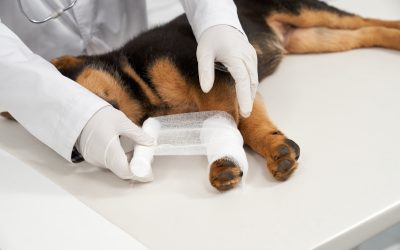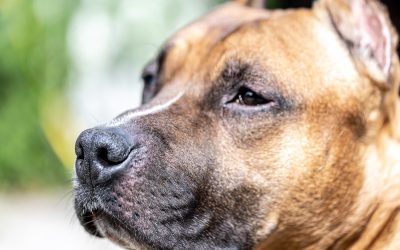Luxating Patella: Signs, Symptoms and Treatment Options

Luxating Patella: Signs, Symptoms and Treatment Options
Is your furry friend limping or showing signs of discomfort in their hind legs? It could be a case of luxating patella, a fairly common orthopedic condition in dogs that can significantly impact their well-being and mobility. However, understanding its causes, symptoms, and treatment options can help you navigate this condition with confidence. This article will provide important details including the signs, symptoms, and treatment options for luxating patella in dogs.
Understanding Luxating Patella
Luxating patella is also commonly known as “trick knee”. A trick knee is a condition in which the kneecap dislocates from its normal position, affecting the dog’s knee joint. The patella normally sits in a groove at the end of the femur, allowing the leg to bend and straighten smoothly. The patella normally sits in a groove at the end of the femur, allowing the leg to bend and straighten smoothly. This displacement can cause pain, lameness, and difficulty in movement, ultimately impacting the dog’s overall quality of life. Dog owners must have a comprehensive understanding of this condition in order to provide the best care for their beloved pets.
Causes of Luxating Patella
Luxating patella can be attributed to various factors, including genetic predisposition and developmental abnormalities. It is more prevalent in small-breed dogs, making them more susceptible to this condition.
Certain dog breeds are particularly prone to luxating patella, including Chihuahuas, Pomeranians, and Yorkshire Terriers.
Types of Luxating Patella
There are different types of luxating patella, each affecting the knee joint in distinct ways. These types include medial and lateral luxation, as well as luxation from trauma. It’s important to understand the specifics of the condition, as each requires different treatments to address the unique challenges it presents.
Medial Luxation
Medial luxation involves the kneecap slipping to the inside of the knee joint, causing discomfort and mobility issues.
Lateral Luxation
Lateral luxation occurs when the kneecap dislocates to the outside of the knee joint, leading to similar symptoms as medial luxation.
Luxation From Trauma
Luxation from trauma can occur due to an injury or accident, causing sudden dislocation of the kneecap. This type of luxating patella requires immediate attention and may necessitate emergency veterinary care.
Symptoms of Luxating Patella
Dogs with luxating patellas may exhibit a range of signs that indicate the presence of this condition. These symptoms can include limping, lameness, and visible discomfort. Additionally, affected dogs might experience difficulty extending or flexing their leg, resulting in observable changes in gait and posture. Understanding and recognizing these symptoms is essential to detecting a luxating patella early.

Diagnosing Luxating Patella
The diagnosis of luxating patella involves a thorough physical examination by a veterinarian. This examination includes palpating the knee joint to detect abnormalities and assess the range of motion. In some cases, radiographic evaluation using X-rays or advanced imaging techniques like MRI or CT scans may be necessary to determine the severity and potential underlying causes of the condition. This will help provide an accurate diagnosis and ultimately develop an effective treatment plan.
If you suspect that your dog may have a luxating patella, it is important to consult with a veterinarian for a proper diagnosis. The vet will conduct a comprehensive examination, assessing the range of motion in your dog’s knee joint and checking for any signs of pain or discomfort. They may also recommend X-rays or other imaging tests to get a better view of the knee joint and determine the severity of the condition.
Treatment Options for Luxating Patella
Treatment for luxating patella can vary depending on the severity of the condition and the specific needs of the dog. The range of treatment options includes conservative management, such as weight management, physical therapy, and medications, as well as surgical interventions like medial patellar luxation correction, trochleoplasty, and lateral imbrication.
Medial Patellar Luxation Correction
A medial patellar luxation correction surgery is often performed to correct the kneecap’s displacement from its normal position. Surgeons typically deepen the groove where the patella is and adjust the surrounding soft tissues to keep it properly aligned.
Trochleoplasty
Trochleoplasty involves reshaping the groove at the end of the femur. This procedure is often the treatment of choice when the groove is very shallow, leading to patellar instability and luxation.
Lateral imbrication
Lateral imbrication involves tightening the soft tissues on the outside of the knee joint to correct medial patellar luxation. Surgeons typically tighten the joint capsule and other ligaments on the lateral side of the knee to prevent the patella from slipping. Lateral imbrication restores the alignment and stability of the knee joint, reduces discomfort, and improves mobility for the affected dog.
The choice of treatment should be based on a thorough evaluation by a veterinarian and a discussion of the potential risks and benefits. The recommendation will likely depend on the severity of the condition and its impact on your dog’s quality of life. In mild cases, conservative management techniques may be sufficient. These can involve exercise modification to avoid activities that put strain on the knee joint, weight management, or the use of pain medication or anti-inflammatory drugs to alleviate discomfort.
While surgery can be successful in correcting luxating patella, it’s important to be aware of potential complications and the associated costs. Dog owners should have a detailed conversation with their veterinarian to fully understand the risks involved in surgical interventions and make an informed decision.
Can Pet Insurance Provide Coverage for Luxating Patella Surgery?

Pet insurance plans may offer coverage for luxating patella surgery. These plans provide various benefits and can be tailored to suit individual needs. Here are the details of the coverage options offered by Odie Pet Insurance:
Illness & Injury Plan
The Illness & Injury Plan is an all-inclusive insurance plan designed to cover a wide range of medical needs for your pet. This plan includes comprehensive coverage for various illnesses, injuries, and veterinary services. Some of the covered items include:
- 24/7 Televet Chat
- Emergency vet visits
- Overnight hospital stays
- IV Fluids & Medications
- Medical Supplies
- Surgeries
- MRI/CAT Scans
- Rehabilitative Care
- Prescription Medications
- Gastrointestinal issues
- Laboratory Tests
Accident-Only Plan
The Accident-Only Plan is designed for pet owners seeking coverage specifically for accidents. This plan provides financial protection for emergency veterinary care resulting from accidental injuries. It includes 90% reimbursement up to $10,000 each year, with a $250 annual deductible.
Here’s an overview of the Accident-Only Plan:
- Coverage for broken bones, sprains, eye injuries, and traumatic dental fractures.
- Coverage for wounds, including bite wounds, lacerations, snake bites, and bee stings.
- Veterinary treatments covered for accidental injuries include X-rays & ultrasounds, laboratory tests, emergency care, hospitalization, CT scan & MRI, and surgery.
Postoperative Care and Recovery
Postoperative care and rehabilitation play a crucial role in the dog’s successful recovery after luxating patella surgery. This includes proper wound care, physical therapy, and long-term monitoring to ensure a positive outcome. Dog owners should closely follow the veterinarian’s instructions and provide a supportive environment for their pet’s recovery.
Preventive Measures
Preventing luxating patella involves a combination of responsible breeding practices, appropriate nutrition and supplements, and managing a dog’s exercise and physical activity to prevent overexertion and injuries. By taking proactive measures, dog owners can help reduce the risk of their pets developing a trick knee and promote overall joint health.
If your dog has been diagnosed with luxating patella, it is important to provide them with a supportive and comfortable environment. This can include providing soft bedding, avoiding slippery surfaces, and ensuring they have easy access to food, water, and outdoor areas. Consistent veterinary check-ups and monitoring for any changes in their condition will also be necessary to ensure their ongoing well-being.
Conclusion
Understanding luxating patella and its management is crucial for dog owners who want to provide the best care for their furry companions. By understanding symptoms and taking proactive measures, you can ensure your beloved pet enjoys a happy, healthy, and active life free from the limitations imposed by the luxating patella.
FAQs
How Long Does Luxating Patella Surgery Take to Perform?
Surgery for a luxating patella varies depending on the specific procedure and treatment. It is best to consult with your veterinarian for a more precise estimate of the surgical duration.
Why Do Little Dogs Skip When They Walk?
Skipping or intermittently lifting a leg while walking can signify discomfort or pain associated with luxating patella. This behavior is often observed in small breed dogs who are more prone to this condition.
Can a Luxating Patella Correct Itself?
In some mild cases, the luxating patella may correct itself temporarily, but long-term management and potential surgical intervention are often necessary to ensure the dog’s well-being and mobility.
How Long Is Recovery from TTT Surgery?
Recovery from Tibial Tuberosity Transposition (TTT) surgery typically involves several weeks of restricted activity and close monitoring by the veterinarian. The exact duration of recovery can vary depending on the individual dog’s response to the surgery and the specific postoperative care provided.
Is Patella Luxation Painful for Dogs?
Luxating patella can cause pain and discomfort for dogs, impacting their mobility and overall well-being. Seeking veterinary care is essential for appropriate management and to alleviate the dog’s pain and discomfort



